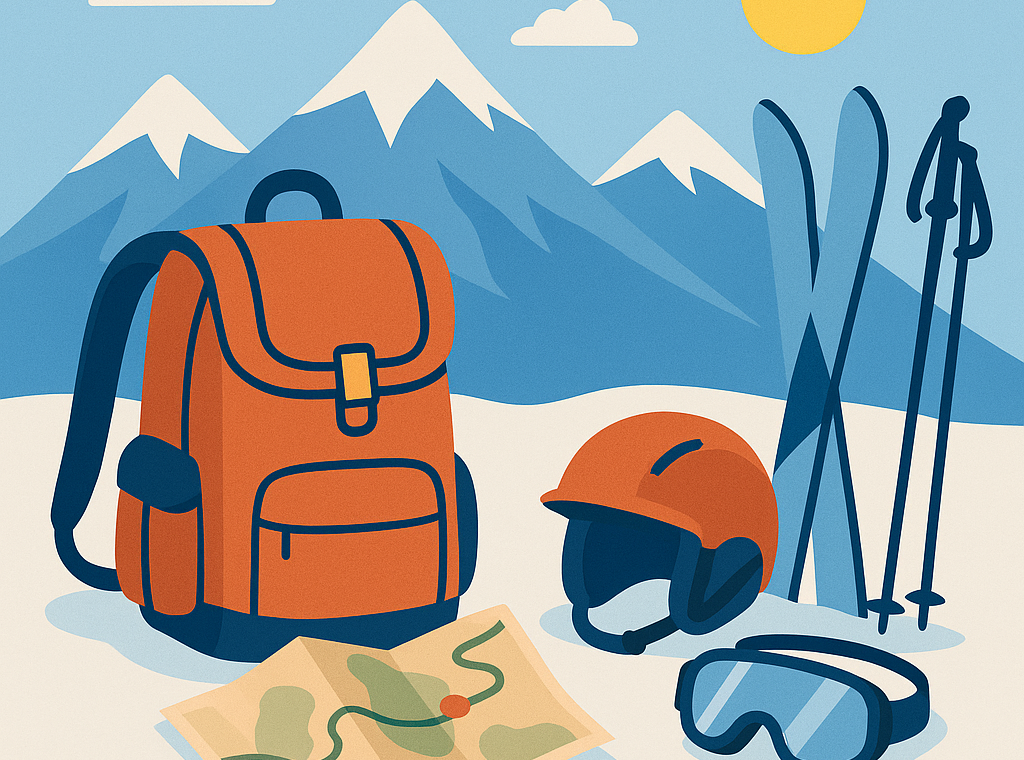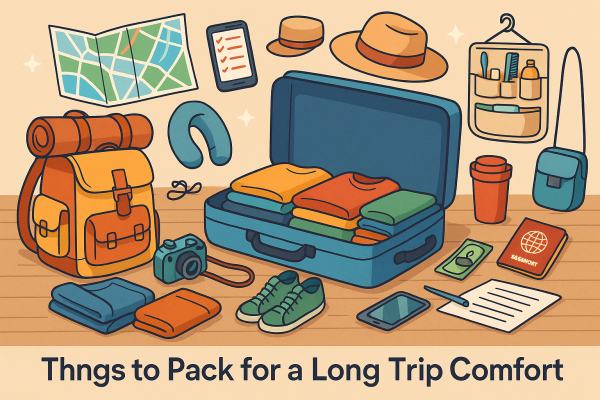What to Pack for a Ski Trip? The Perfect Checklist for Comfort and Safety
Planning an unforgettable ski trip? Don’t hit the slopes unprepared! This comprehensive guide covers everything from essential gear like skis, boots, and helmets to crucial clothing like waterproof jackets, thermal layers, and cozy socks. Learn how layering helps regulate your body temperature and why avoiding cotton is key. Discover safety must-haves, including avalanche gear and first-aid essentials. Plus, get tips for comfortable après-ski attire. Read on to ensure your ski adventure is safe, comfortable, and truly epic!
Important information
- Essential gear includes skis/snowboard, boots, poles, and a helmet.
- Dress in layers of moisture-wicking, non-cotton clothing (base layer, mid-layer, waterproof outer layer) to stay warm and dry.
- Protect your head and eyes with a helmet and goggles or sunglasses.
- Pack safety essentials like sunscreen, a first-aid kit, and avalanche safety gear (beacon, shovel, probe) if skiing off-piste.
- Bring après-ski clothes, toiletries, and other essentials for off-slope comfort.
Ski Trip Packing Checklist: Must-Have Ski Essentials
Pack these essentials for a fantastic ski trip:
- Skis or snowboard, boots, and poles, essential for navigating the slopes.
- Helmet and goggles for crucial head and eye protection.
- Waterproof and insulated ski pants and jacket to stay warm and dry.
- Base layers and thermal underwear to maintain core warmth.
- Fleece mid-layer for added insulation.
- Warm ski socks, gloves or mittens, and a neck warmer to keep extremities cozy.
- Ski pass, wallet, and ID for access and identification.
Creating Your Ski Trip Packing List
Essential Gear:
- skis,
- boots,
- poles,
- helmet.
Clothing for the Slopes:
- waterproof ski jacket,
- waterproof ski pants,
- non-cotton base layers,
- warm gloves,
- wool ski socks,
- goggles.
Off-Slope Essentials:
- après-ski clothes,
- toiletries,
- medications,
- ID and ski pass.
Extra Items for Comfort:
- entertainment,
- snacks (e.g., trail mix),
- reusable water bottle,
- printed packing list.
Essential Ski Gear for Your Adventure
Planning a ski trip? Here’s what you need:
Equipment
- Skis or snowboard,
- Boots,
- Poles.
Safety and Comfort
- Helmet,
- goggles.
Properly sized skis, poles, and well-fitted boots are essential for balance, control, and all-day comfort.
Enjoy your time on the slopes!
Clothing for Comfort and Safety on the Slopes
Start with a thermal base layer. Thermal base layers are crucial for skiing because they wick away sweat, keeping you dry and warm. Opt for merino wool or synthetic fabrics like polypropylene. Avoid cotton, as it absorbs moisture, leaving you cold.
Add a mid-layer for insulation. A fleece or down mid-layer provides essential warmth.
Finish with a waterproof, breathable outer layer. This protects you from snow and wind while allowing excess heat and moisture to escape.
Always choose moisture-wicking fabrics like merino wool, polyester, or nylon for your base and mid-layers. Avoid cotton, as it absorbs moisture and will leave you feeling cold.
Waterproof outerwear is essential. Look for jackets and pants with high waterproof ratings and taped seams for optimal protection.
Protect your head with a ski helmet. Wrist guards are also recommended, especially for beginners, to prevent injuries.
Wear goggles with good visibility and anti-fog features to shield your eyes from snow, wind, and UV rays. Sunglasses are great for sunny days off the slopes.
- Waterproof jacket and pants,
- Thermal underwear,
- A fleece or insulated mid-layer,
- Warm ski socks,
- Waterproof gloves or mittens, and
- A hat or helmet liner.
Choosing the Right Thermal Layers
Merino wool thermal underwear offers superior warmth. Excellent alternatives include synthetics like polyester and polypropylene, known for their moisture-wicking properties, which helps regulate body temperature, keeping you warm, dry, and comfortable.
Why Layering is Key for Warmth
Dressing in layers is crucial for a comfortable ski day, allowing you to adjust to changing weather conditions. Multiple thin layers trap warm air more effectively than one bulky layer, keeping you warm. If you get too warm, remove a layer to prevent overheating and maintain a comfortable temperature. This adaptability is key to enjoying your time on the slopes.
Importance of Waterproof Clothing on a Ski Trip
Waterproof clothing is essential for a comfortable ski trip. A good ski jacket and pants will shield you from snow, sleet, and rain, keeping you warm and dry.
- Specialized gear blocks the elements while allowing sweat to escape, ensuring all-day comfort, even in a blizzard.
- Beyond staying dry, waterproof clothing also helps regulate your body temperature and prevents overheating.
Waterproof clothing is essential for a comfortable ski trip. A good ski jacket and pants will shield you from snow, sleet, and rain.
So, pack your waterproofs and enjoy the slopes!
Avoiding Cotton: The Right Fabrics for Ski Wear
Cotton absorbs moisture, making it unsuitable for skiing and leaving you cold and damp. Instead, opt for moisture-wicking materials like merino wool or synthetics such as polyester and nylon. These fabrics draw sweat away from your skin, keeping you warm and dry even during strenuous activity.
Why avoid cotton?
Cotton absorbs moisture, leaving you cold and damp during skiing.
Best fabrics for skiing
- Merino wool: a natural fiber that wicks away moisture and keeps you warm.
- Polyester: a synthetic material that is durable, moisture-wicking, and quick-drying.
- Nylon: another synthetic option known for its strength, water resistance, and breathability.
Key Ski Clothing to Include
Start with a waterproof and breathable ski jacket and pants to protect yourself from the cold and snow.
Underneath your outer layer, wear thermal base layers made of moisture-wicking material (not cotton) to stay warm and dry.
Add a fleece or wool mid-layer for extra insulation.
Protect your hands with warm, waterproof gloves or mittens, and wear wool ski socks to keep your feet cozy.
Use a neck warmer or gaiter for additional warmth and protection from the elements.
Wear a ski helmet for safety on the slopes.
Helmet and Protective Gear for Safety
A helmet is crucial for head protection, especially for skiers and snowboarders. Wrist guards and back protectors further minimize injury risk. This added safety is even more critical at higher speeds, so consider using them.
- a helmet is essential for head protection, especially for skiers and snowboarders,
- wrist guards and back protectors minimize the risk of injury,
- consider using wrist guards and back protectors, especially at higher speeds.
Goggles and Sunglasses for Eye Protection
Shield your eyes from harsh elements like sun, wind, and snow with goggles. For clear, sunny days, sunglasses are the perfect choice. Enhance your vision further by packing different colored goggle lenses, adapting to various light conditions.
Additional Accessories to Enhance Your Ski Trip
Enhance your ski trip with these essential items:
- Sunscreen (SPF 30 or higher): Protect your skin from intense high-altitude sun.
- Small backpack: Carry essential items like a first-aid kit and toiletries.
- Lip balm with SPF: Shield your lips from dry, cold air.
- Hand and toe warmers: Stay warm on frigid days.
- Neck warmer or gaiter: Protect yourself from the elements.
These additions will significantly improve your time on the slopes.
Choosing the Right Ski Accessories
Enhance your skiing experience with the right accessories. A helmet is essential for safety, while goggles ensure clear vision on the slopes. Keep your hands cozy with gloves or mittens, and don’t underestimate the importance of proper ski socks for warmth and comfort. A neck warmer or balaclava provides added protection against the cold. For frigid conditions, hand and toe warmers offer extra warmth. Carry essentials like water, snacks, and extra layers in a handy backpack. If venturing into the backcountry, prioritize safety with specialized avalanche gear, including a beacon, shovel, and probe.
Importance of Sunscreen with SPF 30+
When you hit the slopes, strong sun protection is essential. The higher altitude means increased sun exposure and stronger UV radiation, significantly raising your sunburn risk. Packing SPF 30+ sunscreen is crucial for blocking these harmful rays and minimizing both immediate sunburn and long-term skin damage.
First Aid Kit and Toiletries: Essentials for the Slopes
Pack a well-stocked first-aid kit for a safe and comfortable ski trip. Be sure to include essentials such as bandages, antiseptic wipes, and pain relievers like ibuprofen or acetaminophen. Blister treatment and personal medications are also crucial. Don’t forget toiletries to combat the harsh winter conditions, including high-SPF lip balm, sunscreen, moisturizer, and hand cream. Travel-sized versions are ideal for maximizing pack space.
Off-Slope and Casual Clothing Essentials
Pack strategically for your après-ski adventures, prioritizing warmth and comfort. A versatile insulated jacket is essential, suitable for both the slopes and relaxing afterward. Layer with cozy sweaters or sweatshirts for extra warmth off the slopes. Comfortable winter boots or sturdy sneakers with good tread are crucial for navigating the resort. Pack casual pants and a nice dinner outfit for evenings out. Don’t forget essentials like t-shirts, jeans, leggings, or sweatpants for casual comfort, along with pajamas, slippers, and a swimsuit for enjoying the hot tub or spa. Casual gloves will provide added warmth.
For the Slopes and Après-Ski
- Insulated jacket: Provides warmth on and off the slopes.
- Sweaters or sweatshirts: Offer extra layering for après-ski warmth.
- Winter boots or sturdy sneakers: Essential for navigating the resort.
Casual Comfort and Evenings Out
- Casual pants: Comfortable for daytime activities.
- Dinner outfit: For enjoying evenings out.
- T-shirts, jeans, leggings, or sweatpants: Provide casual comfort.
- Pajamas and slippers: For relaxing in your accommodation.
- Swimsuit: To enjoy the hot tub or spa.
- Casual gloves: Offer added warmth.
Casual Clothing for Après-Ski Activities
After a long day on the slopes, comfortable après-ski attire is essential. Trade your ski boots for sturdy, comfortable boots and your ski jacket for a warm winter jacket. Don’t forget insulating layers such as sweaters and long pants to stay warm. Accessories like a beanie and warm socks add extra comfort. Pack your swimsuit and flip-flops for a relaxing soak in the hot tub or pool. And, of course, gloves or mittens are essential for keeping your hands warm.
Staying Warm with Casual Layers and Winter Jackets
Prepare for après-ski relaxation with these cozy essentials: a versatile winter jacket suitable for both slopes and lodge, comfortable sweaters, long pants or jeans, casual tops, waterproof and non-slip boots for snowy terrain, and a warm hat, scarf, and gloves to complete the look.
Packing Comfortable Casual Gloves and Waterproof Boots
Après-ski requires the proper equipment. Essential items include warm, casual gloves and waterproof boots, ensuring comfort and dryness while exploring a snowy resort town. Look for insulated gloves and waterproof, insulated boots for optimal protection against the cold.
Preparing for Safety and Emergencies
Avalanche safety gear is essential for backcountry skiing and includes a beacon, shovel, and probe.
Hydration is key, so pack plenty of water.
Bring high-energy snacks to fuel your adventure.
A well-stocked first-aid kit with blister treatment and pain relievers is crucial.
Carry a fully charged phone and a backup power bank for emergency communication.
Avalanche Safety Gear: Beacon, Shovel, Probe
Off-piste skiing requires essential avalanche safety equipment. This includes a beacon, shovel, and probe. These tools are crucial for locating and rescuing buried skiers. A beacon transmits and receives signals to pinpoint a buried person’s location. A shovel enables rapid snow excavation. A probe helps pinpoint their exact position under the snow. An avalanche airbag can significantly increase survival chances. However, equipment alone is not enough. Proper training is essential. Learn how to use your avalanche safety gear effectively. Practice rescue techniques regularly through courses like avalanche safety training. This knowledge could save lives.
Essential Avalanche Safety Equipment:
- Avalanche Beacon: transmits and receives signals to pinpoint the location of buried individuals.
- Shovel: enables rapid snow excavation for faster rescue.
- Probe: helps determine the exact position of a buried person under the snow.
- Avalanche Airbag: significantly increases survival chances in case of an avalanche.
Importance of Training:
Having the right equipment is only half the battle. Proper training is crucial for effective avalanche safety. Consider taking an avalanche safety course to:
- Learn to use your avalanche safety gear effectively.
- Practice rescue techniques regularly.
This knowledge could be lifesaving in a critical situation.
Staying Hydrated with Hydration Packs and Snacks
Staying hydrated is crucial for a great day on the slopes. Here’s how to stay energized:
Hydration packs make sipping easy while skiing.
Portable snacks like granola bars, protein bars, or trail mix provide sustained energy.
Electrolyte drinks or powders replenish essential minerals lost through sweat.
A reusable water bottle, refillable at the resort, is another smart choice.
Small, readily available snacks will keep you energized and hydrated all day long.














